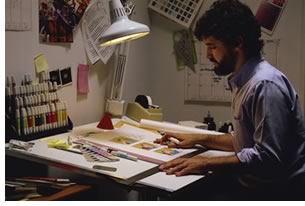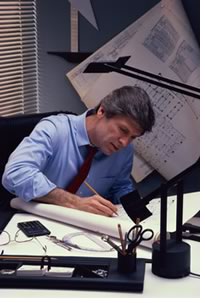

6/2006

by Jack Train, FAIA
As with any professional business, the talent, teamwork, intelligence, and intensity of the personnel are fundamental to the success of an architecture practice. Just as planning is required to create and develop a building, so is planning required to develop staff. We start with a vision, hire the right people, manage their activities, and reward them for their performance.
 Too often, however, firms hire graduates and applicants only
when they need more people, without planning for the development and
future contributions of those people. As a contrast, look at sports teams,
where performance is easily and constantly measured. They do not sit
around waiting for talent to come knocking on the door. They look to
the colleges and interview aggressively. They invest heavily in developing
potential talent. The best architecture firms likewise are forever on
the lookout for individuals they feel have demonstrated abilities and
potential for further development.
Too often, however, firms hire graduates and applicants only
when they need more people, without planning for the development and
future contributions of those people. As a contrast, look at sports teams,
where performance is easily and constantly measured. They do not sit
around waiting for talent to come knocking on the door. They look to
the colleges and interview aggressively. They invest heavily in developing
potential talent. The best architecture firms likewise are forever on
the lookout for individuals they feel have demonstrated abilities and
potential for further development.
Roles within the team
Talent, incidentally, is not limited to design abilities. It is almost
invariably true that design is the primary focus in the schools. Nonetheless,
probably fewer than 5 percent of graduates will function as “designer” in
the top firms. “Design” requires only about 15 percent
of the person-hours in an architecture practice. That is why, in my
practice, we classified senior personnel with prefixes:
- Conceptual Architect, who conceives of design solutions that may be outside his or her previous experience
- Development Architect, a job captain who can take a concept and make it buildable
- Structural Architect and HVAC Architect, people with the technical know-how to guide concept and development
- Administrative Architect, the project manager who has
experience in one of the other roles yet whose higher ability is to
communicate among the various architect roles and with the client.
 These designations are for senior employees. Recent graduates—pre-architects,
as we called them—get as much opportunity as possible to work under
the guidance of these senior people. Executing this policy is not easy
and requires an unselfish director with authority and understanding to
make the policy work.
These designations are for senior employees. Recent graduates—pre-architects,
as we called them—get as much opportunity as possible to work under
the guidance of these senior people. Executing this policy is not easy
and requires an unselfish director with authority and understanding to
make the policy work.
Almost every fresh graduate wants to work in design, even though it is a small percentage who have the ability. And yet it is good for every graduate employee to work with the senior designers to give them an understanding of that process within the firm and to evaluate their abilities. Equally important is to give each fresh employee a chance to work with a development architect—and project engineers—because the learning flows both ways. This training/evaluation loop typically takes about three years.
Of course, there are other roles that must be addressed, whether that talent is in the firm or contracted as a consultant/partner. Those key roles include drafters, specifications writers, cost estimators, engineers, accountants, and office managers.
Find talent to whom you can delegate
Properly evaluating the developing staff is one of the most difficult
and important functions of a firm, because the staff will ultimately
determine the character and success of the firm. Firms will grow and
develop only if employees hired and developed are expected to become
more valuable than current staff.
 Senior staff working with and observing young employees should make
their evaluations. However, the final decision should be made by one
or two people with overall firm responsibility. It is not uncommon for
a senior person to try to keep a bright young employee for his or her
personal team. Because successful firms need a variety of talents, no
one evaluation formula that fits all, but intelligence and dedication
are important in every evaluation.
Senior staff working with and observing young employees should make
their evaluations. However, the final decision should be made by one
or two people with overall firm responsibility. It is not uncommon for
a senior person to try to keep a bright young employee for his or her
personal team. Because successful firms need a variety of talents, no
one evaluation formula that fits all, but intelligence and dedication
are important in every evaluation.
These principles, incidentally, apply to all sizes of firms. It has been said that the size of a firm is ultimately determined by the amount of responsibility the principles are willing to delegate. The one exception is when the building market dries up. There is no task that is more difficult and painful than dismissing loyal and able employees. What is much more rewarding is to guide promising architects toward fulfilling careers.
 Some parting thoughts
Some parting thoughts
To be a manager requires some understanding of what management is all
about. Although some members of architecture firms have specific management
roles, remember that all members have management responsibilities.
Management is the organ of leadership, decision, and direction.
Management is responsible for communications within the organization, making decisions under condition of uncertainty, and strategic planning. It is a practice, not a science. It recognizes that performance is based on both knowledge and responsibility. Directing resources from less productive to more productive activities, management creates wealth and makes an organization perform while addressing its social responsibilities. Managers must lead people rather than contain them, direct rather than control. People are resources and opportunities, not problems, costs, and threats. Above all else, remember that there is no one way to do knowledge work.
Copyright 2006 The American Institute of Architects.
All rights reserved. Home Page ![]()
![]()
Jack Train, FAIA, is the 1974 Edward Kemper recipient for service to the Institute. His work with Skidmore, Owings & Merrill, beginning in the 1940s, included being project manager of the Inland Steel Building in Chicago and the initial Air Force Academy development in Colorado Springs, Colo. As an emeritus principal of Valerio Dewalt Train, he has written The Unsung Essentials of Architectural Practice. Anyone interested in this publication may contact him through AIArchitect.
![]()